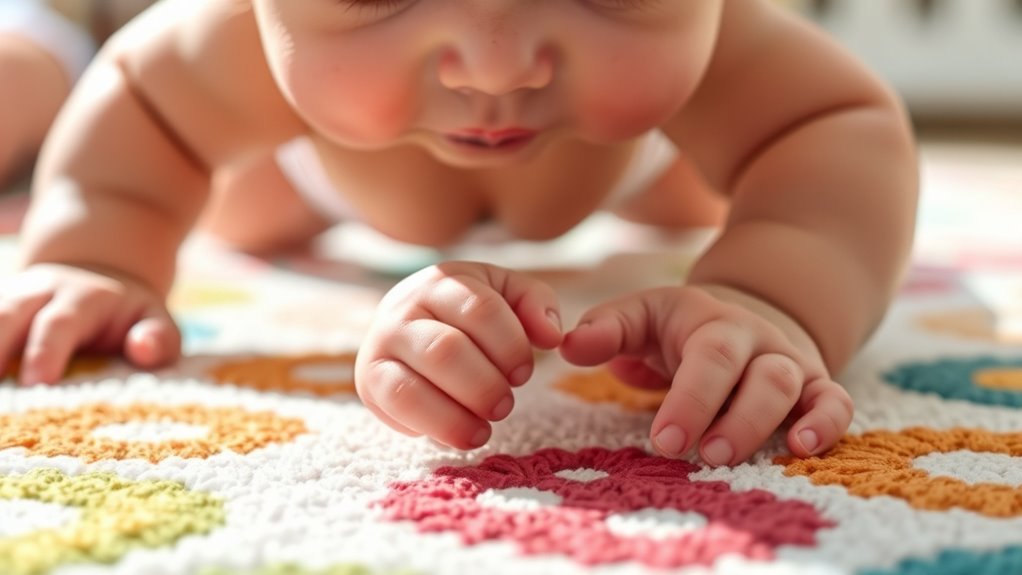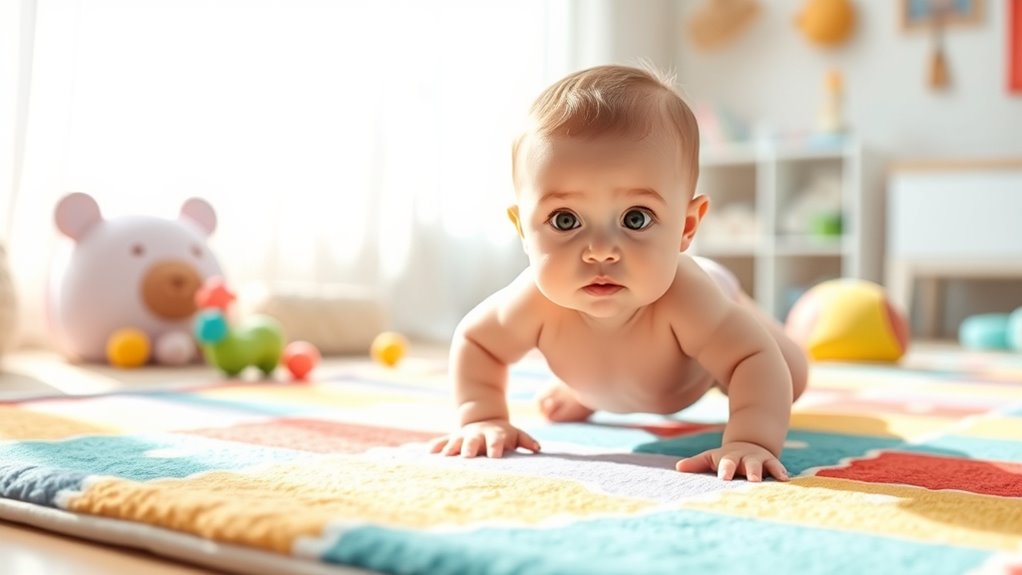Watch for signs your baby is ready to crawl, like pushing up during tummy time, lifting their head, pivoting, or rolling over frequently. To encourage crawling, create a safe, clutter-free space and use colorful toys or mirrors to motivate movement. Incorporate regular tummy time, obstacle courses, and praise to build strength and confidence. Stay attentive to their progress, and keep exploring these tips for more ways to support their crawling journey.
Key Takeaways
- Look for signs like head lifting, pushing up during tummy time, and rolling over frequently.
- Create a safe, clutter-free space with toys and mirrors to motivate movement during tummy time.
- Encourage crawling by setting up obstacle courses with cushions and low objects for exploration.
- Use positive reinforcement and patience to build your baby’s confidence and motivation to crawl.
- Monitor developmental milestones to ensure your baby shows readiness signs before encouraging crawling activities.
Recognizing the Physical Signs of Readiness

Before your baby begins to crawl, you’ll want to look for specific physical signs that they’re ready. One key indicator is increased muscle strength, which you can encourage through regular tummy time. During tummy time, your baby pushes up on their arms and lifts their head, building the muscles needed for crawling. You’ll notice they might start to pivot or shift their weight from side to side, showing developing coordination. Some babies may roll over frequently or attempt to crawl backward before moving forward. These activities demonstrate their growing muscle strength and readiness. Keep in mind, each baby develops at their own pace, but consistent tummy time helps strengthen the muscles essential for crawling. Watch for these signs—they signal your little one is gearing up for this exciting milestone.
Creating a Supportive Environment for Crawling

Creating a supportive environment is essential to encourage your baby’s crawling development. Begin with regular tummy time, which helps strengthen neck, shoulder, and arm muscles necessary for crawling. Make this time enjoyable by engaging your baby with colorful toys or mirrors to motivate movement. Incorporate sensory play by providing textured mats, soft fabrics, and varied objects to stimulate your baby’s senses and curiosity. Clear a safe, clutter-free space where your baby can explore freely without obstacles. Use low furniture or cushions to encourage reaching and pivoting. Incorporating keto-friendly ingredients into your daily routines can also promote overall health and energy levels, supporting your baby’s development. Understanding personal debt forgiveness and how it can impact financial health is important for caregivers managing their finances. Consistently offering these opportunities helps your baby build strength, coordination, and confidence. Developing muscle strength through these activities is vital for successful crawling and future mobility. Additionally, integrating technology in early education like simple interactive toys can further enhance your baby’s learning experiences. Remember, patience and encouragement are key; creating a nurturing environment fosters your baby’s natural crawling progression.
Activities to Encourage and Develop Crawling Skills

Engaging your baby in specific activities can markedly boost their crawling skills. Tummy time is essential, as it strengthens neck, shoulder, and arm muscles needed for crawling. Make sure to supervise your baby during tummy time on a flat, safe surface, gradually increasing the duration. Creating obstacle courses with soft cushions, toys, and low objects encourages your little one to reach, pivot, and navigate, promoting coordination and confidence. Use colorful toys to motivate movement and make the activities fun. Gentle encouragement and praise boost your baby’s motivation to crawl. Remember, consistency is key—incorporate these activities into daily routines. By providing a variety of stimulating environments, you help your baby develop the strength, balance, and curiosity needed to master crawling. Incorporating proper skin care into your routine can also support your baby’s delicate skin during these active phases. Additionally, choosing diverse and creative toys can further stimulate your baby’s desire to explore and move. Being aware of gold IRA options and how they can serve as a secure investment can also help in planning for your child’s future financial stability.
Frequently Asked Questions
When Should I Worry if My Baby Isn’t Crawling Yet?
If you’re wondering when to worry about your baby’s crawling delay, know that most babies reach motor skill milestones between 6 and 10 months. While some may crawl later, persistent delays could signal developmental issues or delays. Keep an eye on other skills, and consult your pediatrician if your baby isn’t showing signs of crawling by around 12 months. Early intervention can help address potential developmental delays effectively.
How Can I Tell if My Baby Is Physically Ready to Crawl?
Think of your baby as a young adventurer at the gates of a new world. You’ll notice signs like increased baby muscle strength, such as holding their head up steadily and pushing up during tummy time. The importance of tummy time can’t be overstated—it helps build the muscles needed for crawling. When your baby shows these strengths, it’s a good indication they’re physically ready to start crawling and exploring.
Are There Any Signs My Baby Is Hesitant to Crawl?
If you notice your baby’s hesitation or crawling reluctance, it might be due to various reasons. Your baby could feel unsure about their coordination or prefer exploring in other ways. Sometimes, they just need more tummy time to build strength. Don’t worry—patience is key. Encourage gentle practice and give them plenty of encouragement. If hesitation persists, consult your pediatrician to rule out any concerns and get personalized advice.
How Do I Prevent My Baby From Developing Delays in Crawling?
Ever wonder how to prevent your baby from developing crawling delays? Start with engaging tummy time routines daily, encouraging your little one to push and explore. Incorporate gentle baby massage to boost muscle strength and coordination. These activities build a solid foundation, but don’t rush—patience is key. Stay attentive to your baby’s cues, and create a playful environment that motivates movement. Your consistent efforts can make all the difference in their crawling progress.
Can Specific Foods or Nutrition Influence Crawling Development?
You might wonder if nutrition impact or food influence can affect your baby’s crawling development. While a balanced diet supports overall growth, specific foods alone don’t directly boost crawling skills. Ensuring your baby gets enough iron, vitamins, and healthy fats is essential for brain and muscle development. Proper nutrition helps your baby reach milestones, but crawling progress depends more on physical readiness and practice than on any particular food.
Conclusion
Remember, every baby crawls in their own time, so stay patient and supportive. By recognizing the signs of readiness, creating a safe space, and encouraging playful activities, you help your little one develop confidence and strength. Keep in mind the saying, “A journey of a thousand miles begins with a single step.” Enjoy this exciting milestone—each crawl brings your baby closer to new adventures and discoveries!










